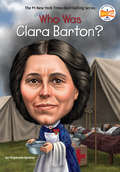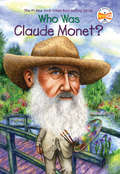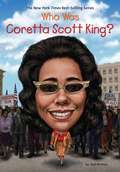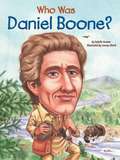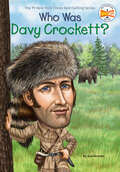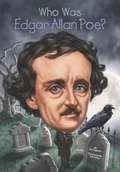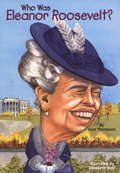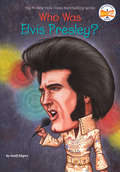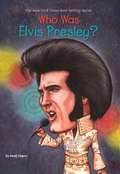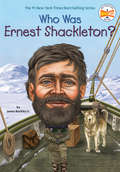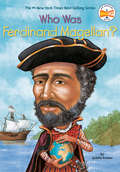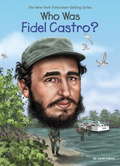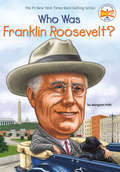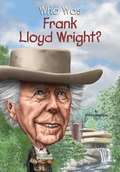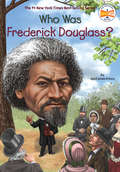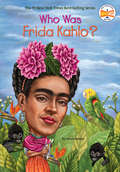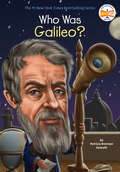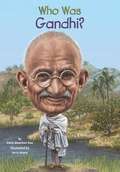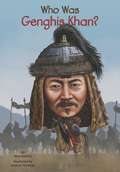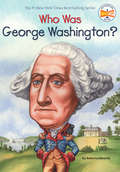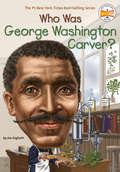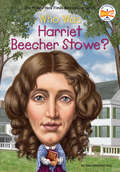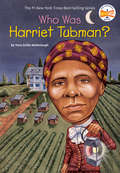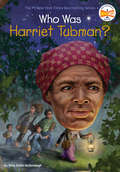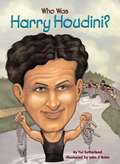Special Collections
Who Was? A Series of Biographies for Kids
- Table View
- List View
Who Was Clara Barton?
by Who HQ and Stephanie SpinnerClarissa “Clara” Barton was a shy girl who grew up to become a teacher, nurse, and humanitarian. At a time when few women worked outside the home, she became the first woman to hold a government job, as a patent clerk in Washington, DC. In 1864, she was appointed “lady in charge” of the hospitals at the front lines of the Union Army, where she became known as the “Angel of the Battlefield.” Clara Barton built a career helping others. She went on to found the American Red Cross, one of her greatest accomplishments, and one of the most recognized organizations in the world.
Who Was Claude Monet?
by Nancy Harrison and Ann Waldron and Stephen MarchesiClaude Monet is considered one of the most influential artists of all time. He is a founder of the French Impressionist art movement, and today his paintings sell for millions of dollars.
While Monet was alive, however, his work was often criticized and he struggled financially. With over one hundred black-and-white illustrations, this book unveils a true portrait of the artist!
Who Was Coretta Scott King?
by Gail Herman and Gregory Copeland and Who HqThe wife of Martin Luther King Jr., Coretta Scott King was a civil rights leader in her own right, playing a prominent role in the African American struggle for racial equality in the 1960s.Here's a gripping portrait of a smart, remarkable woman. Growing up in Alabama, Coretta Scott King graduated valedictorian from her high school before becoming one of the first African American students at Antioch College in Ohio. It was there that she became politically active, joining the local chapter of the National Association for the Advancement of Colored People (NAACP). After her marriage to Martin Luther King Jr., Coretta took part in the Civil Rights Movement. Following her husband's assassination in 1968, she assumed leadership of the movement. Later in life she was an advocate for the Women's Rights Movement, LGBT rights, and she worked to end apartheid in South Africa.
Who Was Daniel Boone?
by Sydelle KramerCalled the "Great Pathfinder", Daniel Boone is most famous for opening up the West to settlers through Kentucky. A symbol of America's pioneering spirit Boone was a skilled outdoorsman and an avid reader although he never attended school.
Sydelle Kramer skillfully recounts Boone's many adventures such as the day he rescued his own daughter from kidnappers.
Who Was Davy Crockett?
by Gail Herman and Nancy Harrison and Robert SquierDavy Crockett, the King of the Wild Frontier, is a man of legend. He is said to have killed his first bear when he was three years old. His smile alone killed another, and he skinned a bear by forcing him to run between two trees. Fact or fiction? Find out the real story of this folk hero, who did love to hunt bears, served as a congressman for Tennessee, and fought and died at the Alamo.
Who Was Edgar Allan Poe?
by Nancy Harrison and Jim Gigliotti and Tim FoleyFilled with broken hearts and black ravens, Edgar Allan Poe's ghastly tales have delighted readers for centuries. Born in Boston in 1809, Poe was orphaned at age two. He was soon adopted by a Virginia family who worked as tombstone merchants. In 1827 he enlisted in the Army and subsequently failed out of West Point. His first published story, The Raven, was a huge success, but his joy was overshadowed by the death of his wife. Poe devoted his life to writing and his tragic life often inspired his work. He is considered to be the inventor of detective fiction and the father of American mystery writers. His work continues to influence popular culture through films, music, literature, and television.
Who Was Eleanor Roosevelt?
by Gare Thompson and Nancy HarrisonFor a long time, the main role of First Ladies was to act as hostesses of the White House...until Eleanor Roosevelt. Born in 1884, Eleanor was not satisfied to just be a glorified hostess for her husband, President Franklin Delano Roosevelt. Eleanor had a voice, and she used it to speak up against poverty and racism. She had experience and knowledge of many issues, and fought for laws to help the less fortunate. She had passion, energy, and a way of speaking that made people listen, and she used these gifts to campaign for her husband and get him elected president-four times! A fascinating historical figure in her own right, Eleanor Roosevelt changed the role of First Lady forever.
Who Was Elvis Presley?
by Geoff Edgers and John O'BrienPut on your blue suede shoes and get ready for another addition to the Who Was…? series! The King could not have come from humbler origins: Born in Tupelo, Mississippi, during the Depression, he grew up with the blues music of the rural South, the gospel music of local churches, and the country-western classics. But he forged a sound all his own—and a look that was all his own, too. With curled lip, swiveling hips, and greased pompadour, Elvis changed popular music forever, ushering in the age of rock and roll. Geoff Edgers’s fascinating biography of this icon of American pop culture includes black and- white illustrations on nearly every spread.
Who Was Elvis Presley?
by Geoff EdgersPut on your blue suede shoes and get ready for the latest title in the Who Was... ? series! The King could not have come from humbler origins: Born in Tupelo, Mississippi, during the Depression, he grew up with the blues music of the rural South, the gospel music of local churches, and the country-western classics. But he forged a sound all his own-and a look that was all his own, too. With curled lip, swivelling hips, and greased pompadour, Elvis changed popular music forever, ushering in the age of rock and roll. Geoff Edgers's fascinating biography of this icon of American pop culture includes black and- white illustrations on nearly every spread.
Who Was Ernest Shackleton?
by James Buckley and Max HergenrotherAs a boy he preferred reading sea stories to doing homework and, at age 16, became an apprentice seaman. Subsequently, Ernest Shackleton's incredible journeys to the South Pole in the early 1900s made him one of the most famous explorers of modern times. His courage in the face of dangerous conditions and unforeseeable tragedies reveal the great leader that he was. His historic 1914 journey aboard the Endurance has all the drama of an action movie.
Who Was Ferdinand Magellan?
by Nancy Harrison and Elizabeth Wolf and S. A. KramerWhen Portuguese sailor Ferdinand Magellan set sail from Spain in 1519, he believed he could get to the Spice Islands by sailing west through or around the New World. He was right, but what he didn't know was that the treacherous voyage would take him three years and cost him his life. Black-and-white line drawings illustrate Magellan's life and voyage, with sidebars and a time line that enhance readers' understanding of the period.
Who Was Fidel Castro?
by Ted Hammond and Sarah FabinyWhen Fidel Castro died on November 25, 2016, many people around the world responded with mixed emotions. Learn all about the man who shaped Cuba for more than half a decade.After overthrowing Fulgencia Batista in 1959, Fidel Castro became the leader of an island country only ninety miles away from Florida. While in power, Castro outlasted ten US presidents and turned the small nation into a one-party state with influence over the entire world. Called a leader by some and a dictator by others, Castro defined not one but several eras in world politics.
Who Was Franklin Roosevelt?
by Margaret Frith and John O'Brien and Nancy HarrisonAlthough polio left him wheelchair bound, Franklin Delano Roosevelt took office during the Great Depression and served as president during World War II. Elected four times, he spent thirteen years in the White House. How he led the country through tremendously difficult problems, much like the ones facing America today, makes for a timely and engrossing biography.
Who Was Frank Lloyd Wright?
by Nancy Harrison and Gregory Copeland and Ellen LabrecqueBorn in Wisconsin in 1867, Frank Lloyd Wright became obsessed with a set of building blocks his mother had given to him on his ninth birthday. He grew up to become the father of organic architecture and the greatest American architect of all time, having designed more than 1,100 buildings during his lifetime. These included private homes - such as the stunning Fallingwater, churches, temples, a hotel, and the world-famous Guggenheim Museum in New York City. When asked how he could create so many designs, he answered, "I can't get them out fast enough." Frank Lloyd Wright was a man ahead of his time who could barely keep up with his own ideas!
Who Was Frederick Douglass?
by April Jones Prince and Nancy Harrison and Robert SquierBorn into slavery in Maryland in 1818, Frederick Douglass was determined to gain freedom--and once he realized that knowledge was power, he secretly learned to read and write to give himself an advantage. After escaping to the North in 1838, as a free man he gave powerful speeches about his experience as a slave. He was so impressive that he became a friend of President Abraham Lincoln, as well as one of the most famous abolitionists of the nineteenth century.
Who Was Frida Kahlo?
by Jerry Hoare and Sarah FabinyYou can always recognize a painting by Kahlo because she is in nearly all--with her black braided hair and colorful Mexican outfits. A brave woman who was an invalid most of her life, she transformed herself into a living work of art. As famous for her self-portraits and haunting imagery as she was for her marriage to another famous artist, Diego Rivera, this strong and courageous painter was inspired by the ancient culture and history of her beloved homeland, Mexico. Her paintings continue to inform and inspire popular culture around the world.
Who Was Galileo?
by John O'Brien and Nancy Harrison and Patricia Brennan DemuthLike Michelangelo, Galileo is another Renaissance great known just by his first name--a name that is synonymous with scientific achievement. Born in Pisa, Italy, in the sixteenth century, Galileo contributed to the era's great rebirth of knowledge. He invented a telescope to observe the heavens. From there, not even the sky was the limit! He turned long-held notions about the universe topsy turvy with his support of a sun-centric solar system. Patricia Brennan Demuth offers a sympathetic portrait of a brilliant man who lived in a time when speaking scientific truth to those in power was still a dangerous proposition.
Who Was Gandhi?
by Nancy Harrison and Dana Meachen Rau and Jerry HoareMohandas Karamchand Gandhi was born in 1869 in British-occupied India. Though he studied law in London and spent his early adulthood in South Africa, he remained devoted to his homeland and spent the later part of his life working to make India an independent nation. Calling for non-violent civil disobedience, Gandhi led India to independence and inspired movements for civil rights around the world. Gandhi is recognized internationally as a symbol of hope, peace, and freedom.
Who Was Genghis Khan?
by Andrew Thomson and Nico Medina and Nancy HarrisonNamed Temujin at birth by his nomadic family in early Mongolia, the great Genghis Khan used his skill and cunning to create the Mongol Empire and conquer almost the entire continent of Asia. As ruler of the largest empire in human history, he was as respected as he was feared. Learn more about the man and the legend in Who Was Genghis Khan?
Who Was George Washington?
by Roberta Edwards and True Kelley and Nancy HarrisonIn 1789, George Washington became the first president of the United States. He has been called the father of our country for leading America through its early years.
Washington also served in two major wars during his lifetime: the French and Indian War and the American Revolution. With over 100 black-and-white illustrations, Washington's fascinating story comes to life - revealing the real man, not just the face on the dollar bill!
Who Was George Washington Carver?
by Nancy Harrison and Stephen Marchesi and Jim GigliottiBorn in 1860s Missouri, nobody expected George Washingtoni Carver to succeed. Slaves were not allowed to be educated. After the Civil War, Carver enrolled in classes and proved to be a star student. He became the first black student at Iowa State Agricultural College and later its first black professor. He went on to the Tuskegee Institute where he specialized in botany (the study of plants) and developed techniques to grow crops better. His work with vegetables, especially peanuts, made him famous and changed agriculture forever. He went on to develop nearly 100 household products and over 100 recipes using peanuts.
Who Was Harriet Beecher Stowe?
by Nancy Harrison and Dana Meachen Rau and Gregory CopelandBorn in Connecticut in 1811, Harriet Beecher Stowe was an abolitionist, author, and playwright. Slavery was a major industry in the American South, and Stowe worked with the Underground Railroad to help escaped slaves head north towards freedom. The publication of her book, Uncle Tom's Cabin, a scathing anti-slavery novel, fanned the flames that started the Civil War. The book's emotional portrayal of the impact of slavery captured the nation's attention. A best-seller in its time, Uncle Tom's Cabin sealed Harriet Beecher Stowe's reputations as one of the most influential anti-slavery voices in US history.
Who Was Harriet Tubman?
by Yona Zeldis Mcdonough and Nancy HarrisonBorn a slave in Maryland, Harriet Tubman knew first-hand what it meant to be someone's property; she was whipped by owners and almost killed by an overseer. It was from other field hands that she first heard about the Underground Railroad which she travelled by herself north to Philadelphia. Throughout her long life (she died at the age of ninety-two) and long after the Civil War brought an end to slavery, this amazing woman was proof of what just one person can do.
Who Was Harriet Tubman?
by Yona Zeldis McDonough and Who HQBorn a slave in Maryland, Harriet Tubman knew first-hand what it meant to be someone's property; she was whipped by owners and almost killed by an overseer. It was from other field hands that she first heard about the Underground Railroad which she travelled by herself north to Philadelphia. Throughout her long life (she died at the age of ninety-two) and long after the Civil War brought an end to slavery, this amazing woman was proof of what just one person can do.
Who Was Harry Houdini?
by Tui Sutherland and John O'Brien and Nancy HarrisonEvery kid has heard of Harry Houdini, the famous magician who could escape from handcuffs, jail cells, and locked trunks. But do they know that the ever-ambitious and adventurous Houdini was also a famous movie star and the first pilot to fly a plane in Australia? This well-told biography is full of the details of Houdini's life that kids will really want to know about and illustrated throughout with beautiful black-and-white line drawings. Illustrated by John O'Brien.
